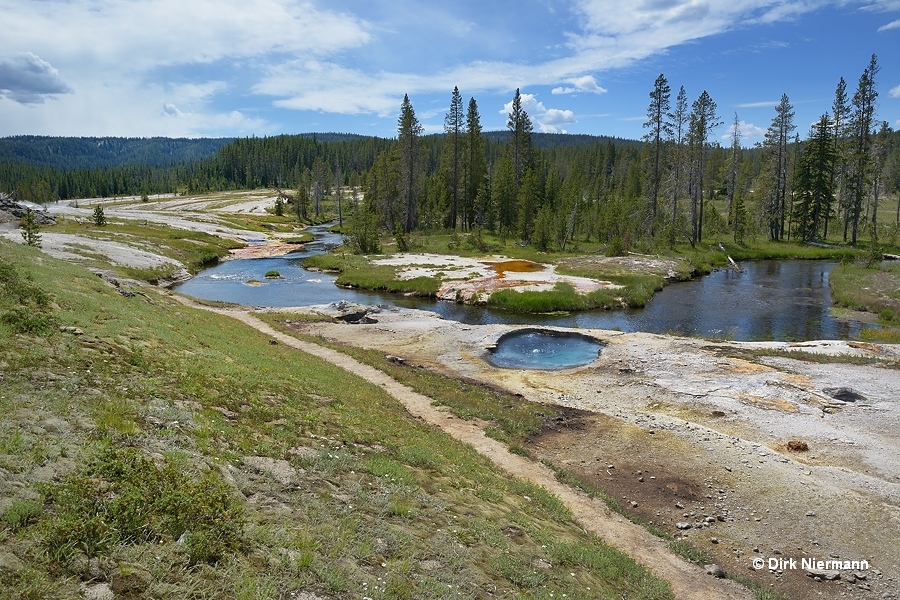Shoshone Geyser Basin of Yellowstone
With more than 80 geysers and numerous hot springs, Shoshone Basin is one of the most important geyser sites worldwide. In contrast to the very similar Upper Basin, where the thermal features are lined up along Firehole River, the banks of Shoshone Creek are occupied by smaller geysers. Due to its remoteness the setting is in near pristine state and gives an impression of how other Yellowstone geyser basins may have looked like in the past. Unfortunately, it is only near pristine and not untouched, because even here vandals have caused damage to some important features, such as Union Geyser, Minute Man Geyser, or Little Bulger Geyser. It should also be mentioned that a hot spring of the Minute Man Group (see details there) claimed a human life in 1988.
The best protection against mass tourism is provided by its remote location 13.5 km (8.5 miles) away from the next trailhead you can reach by motorized vehicles. Starting at Kepler Cascades it is a quite easy 3.5 hours hike to Shoshone Lake. As with all backcountry thermal areas, a visit of Shoshone Basin requires appropriate knowledge and skills to ensure your safety. This is also true for a possible encounter with wildlife, especially bears, bison, and moose (and clouds of mosquitoes in June and July). In general it is still possible to explore all important thermal areas of the basin, but some paths or sections may be (temporarily?) closed by warning signs. If so, stick to it, of course. (Update: Unfortunately, all thermal groups west of Shoshone Creek have been closed to public entry since 2016).

Even if nowadays Shoshone Geyser Basin lies a little bit apart, in the 19th century it was one of the first thermal areas in the Yellowstone region visited by white men. Provably, fur trappers reached Shoshone Lake and the geyser basin in 1839, perhaps even earlier. Subsequently, most of the major geological surveys, for example the Hayden Expeditions in 1871, 1872, and 1878, made halt at Shoshone Geyser Basin and conducted some investigations. Names like Camp Group, Horse Camp Group, Horse Trail Springs, or Kitchen Spring bear witness to these historical visits, and many further hot springs and geysers have been named by participants of these expeditions. The party of the Hayden Geological Survey of 1872 even regarded "the ornamentation about these springs as more interesting and elaborate than those in the Firehole Basin". I think they were right about that.
Shoshone Geyser Basin breaks down into eight thermal groups east of Shoshone Creek and six groups west of it. East of the creek are located (from north to south): Bog Spring Group (off-trail), Shore Group (along the west shore of the lake's Basin Bay), Little Giant Group (west of and adjacent to the Continental Divide Trail), Sulphur Hills Group (east of the trail), Minute Man Group, Orion Group (both crossed by the trail), Camp Group, and Lake Group east of Orion Group, next to the southern tip of Basin Bay. West of Shoshone Creek are to be found (from north to south): Yellow Crater Group, North Group, South Group (all three are located along the trail), West Group (southwest of South Group), Island Group, and Horse Camp Group (both crossed by the trail). The trail west of Shoshone Creek in places has deteriorated beyond recognition, though, in particular within the northern groups.
Currently, the most significant active geysers are above all situated in the North Group, the Minute Man Group, and the Little Giant Group. Up into the 1970s, Union Geyser in the Orion Group was the tallest spouter of Shoshone Basin, but it went dormant at the end of that decade and around the same time also the activity of other geysers throughout the entire group dropped to almost zero.